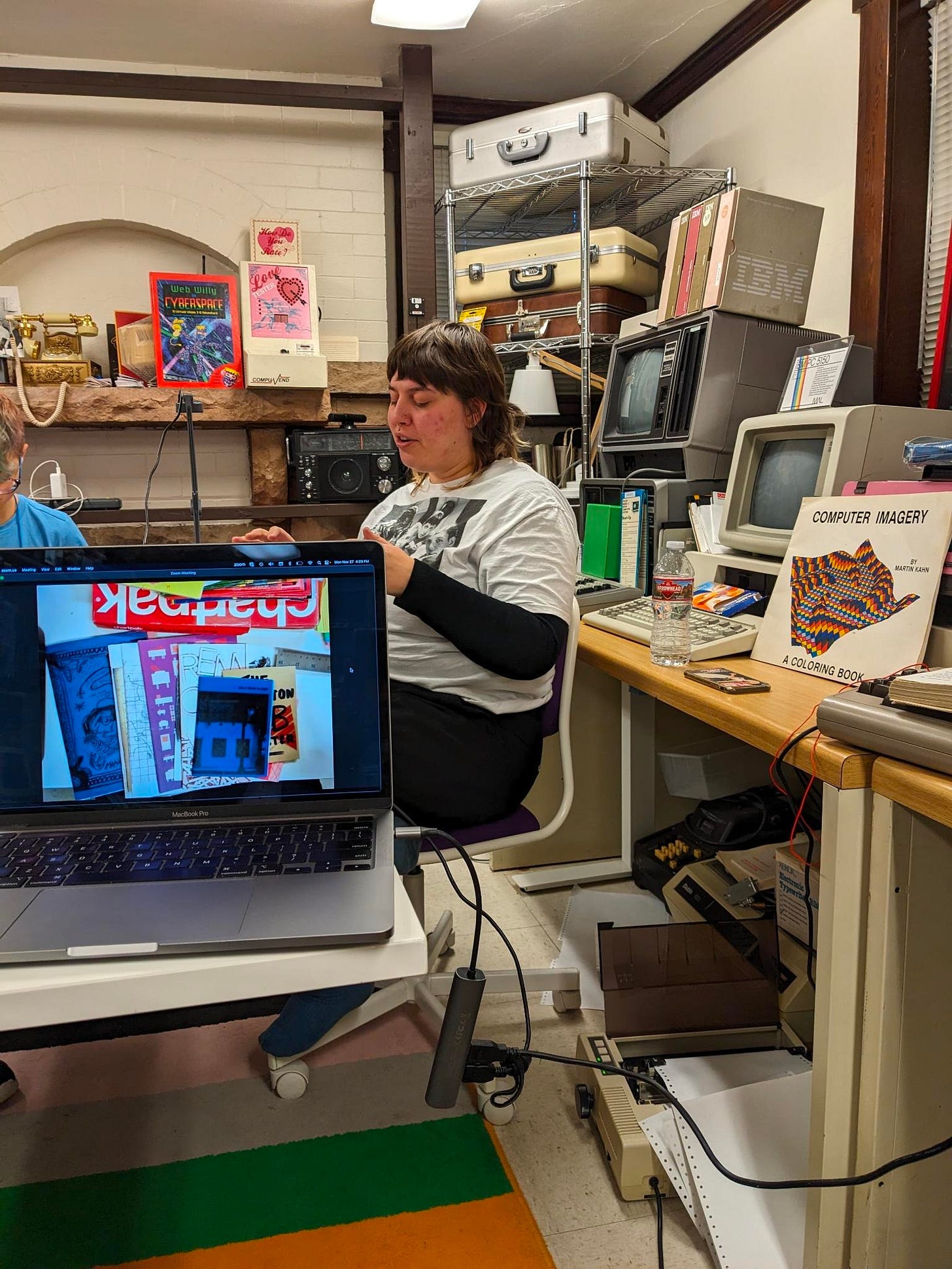We had so much happen in the last two months!
First off, midway through October we had the absolute pleasure of working with some other organizations on campus to host Rick Prelinger of the Prelinger Archive. He presented two talks (“Exploring the Other Spectrum:
Useful Radio” and “Quiet Archives and Noisy Audiences: Building a Future for Film”) and we hosted a listening workshop on accessing useful radio. We’re working to bring him back for some dedicated time for hands-on and practical work around useful radio in the future - let us know if you have an idea about projects that would make sense in the Boulder area.
Though November is always a bit quieter because of the Thanksgiving break, we managed to pack in a number of class visits and virtual tours. We also were thrilled to host Sid Drmay, our November practitioner-in-residence, as they explored our archives to create 1 full-size and 9 (!) mini-zines. The full-size zine will be available soon both digitally and in-person at the lab, and a limited run of the mini-zines will be available for free from our Art-O-Mat vending machine on the lab’s front porch.
As part of their residency, Sid led an experimental zine-making workshop centered around ideas of utopia and had participants each create a page, which will form the basis of a collaborative zine. Watch for the next ephemerMAL prompt, Sid will be the guest curator for the next issue.
While here, Sid also nudged us into hosting an impromptu noise show in the lab, featuring Denver artists Laudanum Quilt, Muttering and Kneiffii. Video from that show can be found on our Instagram - and so many thanks to D. Brigman for putting together such a fantastic bill!
Our December practitioners-in-residence are Lee Cyborg and Emily Francisco!
Emily will be installing her Trans-Harmonium in the lab for the month of December. Describing the project, Emily says: Collecting Fragments of Time is a series of recordings involving decommissioned objects transfigured into instruments that pull live radio frequencies from the air. These recordings are being compiled to create an archive of fragmented time. The Archive of Fragmented Time will exist as a physical drive containing images and video files in addition to existing in various forms on the internet. Contributions to the archive can be submitted via email or social media tagging, or using the hashtag #collectingfragmentsoftime on Instagram TikTok or the media platform of your choice.
The Trans-Harmonium is part of this project. The Trans-Harmonium is a deconstructed antique piano re-wired to play a collection of radios tuned to twelve frequencies, one frequency for each key chromatically. C is reserved for classical when possible, while A, B, D, E, F, G are tuned chronologically based on local stations. The sharps/flats are tuned in between stations, picking up static and overlapping dialog. I have toy nutcrackers that speak the language of live talk radio when their mouths open. I activate FM frequencies with a violin tuned to trigger a system of stations. These recontextualized objects function as access points to voices and songs competing to be heard.
We will have a live virtual session with Emily on December 11th at 4pm CO time - email mediaarchaeology+rsvp@colorado.edu to RSVP. She’ll explain the project and give more in-depth instructions for interacting with the the device, but the Trans-Harmonium will be on view and available for interaction starting December 4th.
Lee will be dedicating their time in the lab to exploring amateur astronomy tools within the collection. Explaining their goals, Lee says: With the current renewed interest in outer space technologies, I believe its important to make visible what is both different and similar about current and historical citizen-led astronomy and interrogate image production that informs how we imagine outer space. Outer space infrastructure is a mixture of both new and old technologies, making this work relevant today. I am interested in looking at how citizens can have access to images that are interpreted and disturbed by governments and agencies with political agendas, and what tools exist to analyze, process, and re-distribute those images on our own terms.
Lee will be demonstrating their Slow-Scan Television selfie station during a happy hour gathering on Dec. 18 from 4-6 - email us if you’re in the area and would like to attend!
Our volunteers continue to do awesome work around the lab. Some recent projects include getting our IBM 5150 computer online with a dedicated ethernet connection, doing some minor repair work on various machines to get them back in working condition, and getting our Commodore talking to a dot matrix printer.
We’re very thankful that we are able to keep expanding our volunteer base and our connections with other institutions. You may know we are already an approved Community Engagement site for New Vista High School students and have a dedicated crew of teenagers working with the lab each week, and starting next semester we will also be an internship site for the Denver University Masters of Library & Information Science program. If you (or someone you know) are interested in volunteering, don’t hesitate to reach out! We’re always looking for folks to host open house hours, and we also always need help with various machine repairs around the lab, some of which can certainly be done off-site.
That’s all the news for now - please forgive us if we send out an extra email with announcements this month. We’ve got a lot of exciting stuff coming up and we’d hate for you to miss out!
More soon -
Your friends at the MAL





